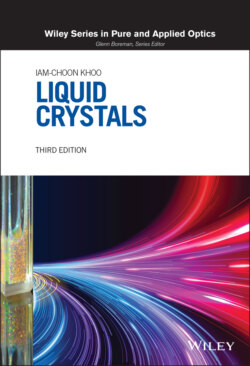Читать книгу Liquid Crystals - Iam-Choon Khoo - Страница 31
2 Order Parameter, Phase Transition, and Free Energies 2.1. BASIC CONCEPTS 2.1.1. Introduction
ОглавлениеIn the ordered phase, liquid crystals possess both crystalline and fluid properties. The theoretical framework for describing the crystalline properties of liquid crystals, termed elastic or continuum theory, is closer in form to that of solids and invokes similar classical mechanics terminology such as elastic constant, distortion energy, torque, free energies, etc. What makes liquid crystals unique is the fact that in such an ordered phase they also possess many fluidic properties similar to ordinary liquids. Nematic liquid crystals, for example, flow like liquids and thus require hydrodynamical theories for their complete description. These crystalline and flow properties of nematics are explained in further detail in the next chapter.
In the disordered or isotropic phase, they behave like ordinary fluids of anisotropic molecules. They can thus be described by theories pertaining to anisotropic fluids. However, at the vicinity of the isotropic → nematic phase transition point, liquid crystals exhibit some highly correlated pre‐transitional effects such as enhanced but critically slowed response to external fields, owing to increased intermolecular correlations near the phase transition.
In the following sections, we introduce some basic concepts and definitions, such as order parameter, short‐ and long‐range order, phase transition, and so on, which form the basis for describing the ordered and disordered phases of liquid crystals. Most of the discussions pertain to the exemplary nematic liquid crystals. Information on other phases may be found in later chapters and the references quoted therein.
